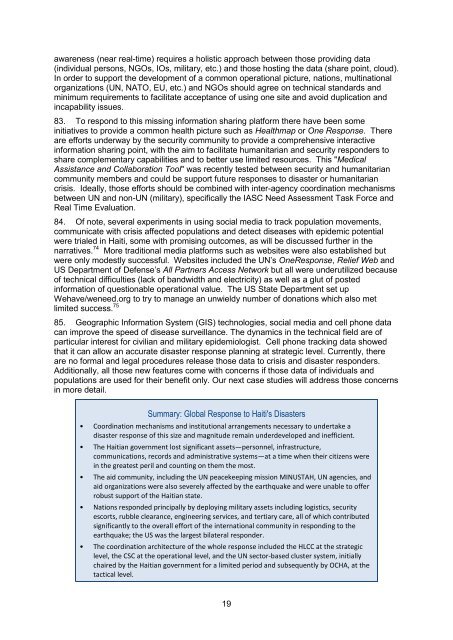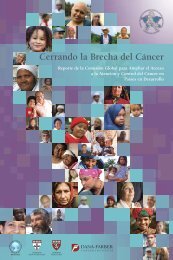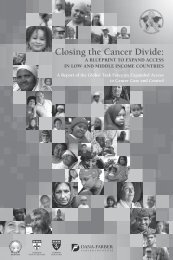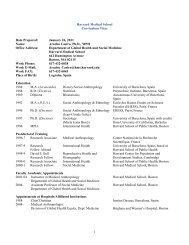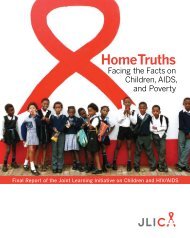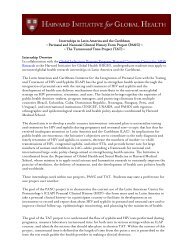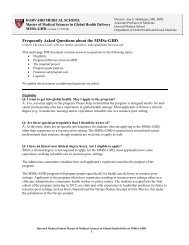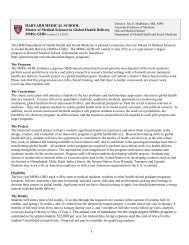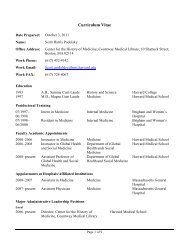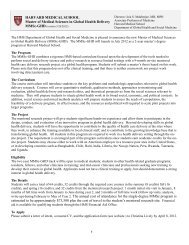Haiti Case Study - The Department of Global Health and Social ...
Haiti Case Study - The Department of Global Health and Social ...
Haiti Case Study - The Department of Global Health and Social ...
You also want an ePaper? Increase the reach of your titles
YUMPU automatically turns print PDFs into web optimized ePapers that Google loves.
awareness (near real-time) requires a holistic approach between those providing data<br />
(individual persons, NGOs, IOs, military, etc.) <strong>and</strong> those hosting the data (share point, cloud).<br />
In order to support the development <strong>of</strong> a common operational picture, nations, multinational<br />
organizations (UN, NATO, EU, etc.) <strong>and</strong> NGOs should agree on technical st<strong>and</strong>ards <strong>and</strong><br />
minimum requirements to facilitate acceptance <strong>of</strong> using one site <strong>and</strong> avoid duplication <strong>and</strong><br />
incapability issues.<br />
83. To respond to this missing information sharing platform there have been some<br />
initiatives to provide a common health picture such as <strong>Health</strong>map or One Response. <strong>The</strong>re<br />
are efforts underway by the security community to provide a comprehensive interactive<br />
information sharing point, with the aim to facilitate humanitarian <strong>and</strong> security responders to<br />
share complementary capabilities <strong>and</strong> to better use limited resources. This "Medical<br />
Assistance <strong>and</strong> Collaboration Tool" was recently tested between security <strong>and</strong> humanitarian<br />
community members <strong>and</strong> could be support future responses to disaster or humanitarian<br />
crisis. Ideally, those efforts should be combined with inter-agency coordination mechanisms<br />
between UN <strong>and</strong> non-UN (military), specifically the IASC Need Assessment Task Force <strong>and</strong><br />
Real Time Evaluation.<br />
84. Of note, several experiments in using social media to track population movements,<br />
communicate with crisis affected populations <strong>and</strong> detect diseases with epidemic potential<br />
were trialed in <strong>Haiti</strong>, some with promising outcomes, as will be discussed further in the<br />
narratives. 74 More traditional media platforms such as websites were also established but<br />
were only modestly successful. Websites included the UN’s OneResponse, Relief Web <strong>and</strong><br />
US <strong>Department</strong> <strong>of</strong> Defense’s All Partners Access Network but all were underutilized because<br />
<strong>of</strong> technical difficulties (lack <strong>of</strong> b<strong>and</strong>width <strong>and</strong> electricity) as well as a glut <strong>of</strong> posted<br />
information <strong>of</strong> questionable operational value. <strong>The</strong> US State <strong>Department</strong> set up<br />
Wehave/weneed.org to try to manage an unwieldy number <strong>of</strong> donations which also met<br />
limited success. 75<br />
85. Geographic Information System (GIS) technologies, social media <strong>and</strong> cell phone data<br />
can improve the speed <strong>of</strong> disease surveillance. <strong>The</strong> dynamics in the technical field are <strong>of</strong><br />
particular interest for civilian <strong>and</strong> military epidemiologist. Cell phone tracking data showed<br />
that it can allow an accurate disaster response planning at strategic level. Currently, there<br />
are no formal <strong>and</strong> legal procedures release those data to crisis <strong>and</strong> disaster responders.<br />
Additionally, all those new features come with concerns if those data <strong>of</strong> individuals <strong>and</strong><br />
populations are used for their benefit only. Our next case studies will address those concerns<br />
in more detail.<br />
Summary: <strong>Global</strong> Response to <strong>Haiti</strong>'s Disasters<br />
• Coordination mechanisms <strong>and</strong> institutional arrangements necessary to undertake a<br />
disaster response <strong>of</strong> this size <strong>and</strong> magnitude remain underdeveloped <strong>and</strong> inefficient.<br />
• <strong>The</strong> <strong>Haiti</strong>an government lost significant assets—personnel, infrastructure,<br />
communications, records <strong>and</strong> administrative systems—at a time when their citizens were<br />
in the greatest peril <strong>and</strong> counting on them the most.<br />
• <strong>The</strong> aid community, including the UN peacekeeping mission MINUSTAH, UN agencies, <strong>and</strong><br />
aid organizations were also severely affected by the earthquake <strong>and</strong> were unable to <strong>of</strong>fer<br />
robust support <strong>of</strong> the <strong>Haiti</strong>an state.<br />
• Nations responded principally by deploying military assets including logistics, security<br />
escorts, rubble clearance, engineering services, <strong>and</strong> tertiary care, all <strong>of</strong> which contributed<br />
significantly to the overall effort <strong>of</strong> the international community in responding to the<br />
earthquake; the US was the largest bilateral responder.<br />
• <strong>The</strong> coordination architecture <strong>of</strong> the whole response included the HLCC at the strategic<br />
level, the CSC at the operational level, <strong>and</strong> the UN sector-based cluster system, initially<br />
chaired by the <strong>Haiti</strong>an government for a limited period <strong>and</strong> subsequently by OCHA, at the<br />
tactical level.<br />
19


